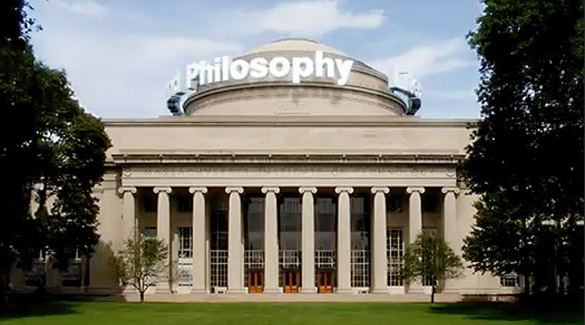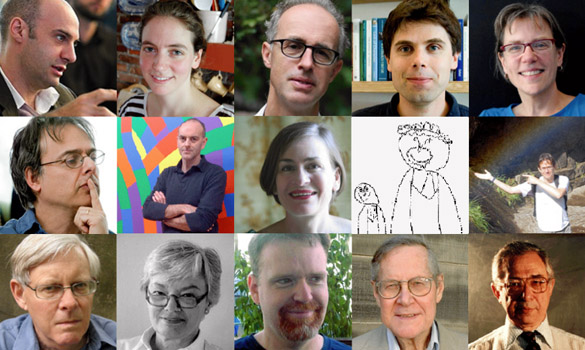CORE: EDUCATION
Outsized Influence
MIT Philosophy has extraordinary success placing PhD graduates in top tenure-track positions

"The thing about MIT is that you show up there and people are talking philosophy in the halls."
— Selim Berker PhD ’07, Assistant Professor of Philosophy, Harvard University
Consistently ranked among the top ten philosophy departments in the country, MIT’s small Philosophy section—just 12 full time professors—recently drew attention for its extraordinary success in placing PhD graduates in tenure-track positions at top philosophy programs nationwide, among them Rutgers, Harvard, Princeton, University of Michigan–Ann Arbor, Yale, and Stanford.
Analyzing grad student placements in philosophy, the influential Leiter Reports puts MIT second only to New York University, whose philosophy program is nearly twice as large. Because obtaining a faculty position in philosophy is notoriously difficult—there are often 700 applicants for every appointment—many are wondering: what is the secret of MIT Philosophy's outsized success?
What is the secret?
Naturally, MIT draws excellent PhD candidates, says Professor Richard Holton, head of the Department of Linguistics and Philosophy. But both Holton and those who have gone through the program also credit MIT’s unique culture for encouraging hard work and collaborative effort.
“[MIT has] a very cooperative, friendly, and very philosophically engaged environment,” says alumna Elizabeth Harman PhD ’03, an associate professor of philosophy at Princeton University. “Let’s all roll up our sleeves and solve these problems together. That was the attitude faculty had, and students had it too.”
“MIT the institution has a distinctive consciousness,” says Jason Stanley PhD ’95, a professor of philosophy at Rutgers University. “Philosophy has to be honest work, and that’s very MIT.”
Agenda-setting graduates
“One thing that you see with successful grad programs is that they’re agenda-setting," says Stanley. "Clusters of papers will come out of a group of grad programs—that has happened at MIT several times."
For example, MIT Professor Robert Stalnaker, Delia Graff Fara PhD '97 (a professor at Princeton), Robert J. Stainton ’93 (Distinguished University Professor at Western Ontario), Zoltán Gendler Szabó PhD ’95, and Stanley have all produced influential work on the topic of context-dependence, responding and building on one another's views. More recently, a number of MIT alumni have contributed influential, mutually supportive work on modality.
“A lot of us [MIT grad students] wrote about each other’s work because we grew up criticizing each other’s works. In our generation there were certain topics that were discussed a lot, that we all talked about incessantly with each other, that resulted in a host of papers,” Stanley says.

Top row: Agustín Rayo, Julia Markovits, Richard Holton, Caspar Hare, Sally Haslanger
Middle row: Stephen Yablo, Alex Byrne, Rae Langton, Vann McGee, Brad Scow
Bottom row: Robert Stalnaker, Judith Thomson, Roger White, Irving Singer, Sylvain Bromberger
Contemporary Philosophers | Photographs by Steven Pyke
including photographs of several MIT philosophers
Collaborative culture
Collaboration is also common. Stanley teamed up with one of his classmates—Szabó, now a professor of philosophy and linguistics at Yale—to write “On Quantifier Domain Restriction,” a paper published in Mind & Language in 2000. And, Tyler Doggett PhD ’04 (an assistant professor at the University of Vermont) and classmate Andy Egan PhD ’04 (an associate professor at Rutgers) co-authored “How We Feel About Terrible, Non-Existent Mafiosi” in Philosophy and Phenomenological Research in 2011.
“The thing about MIT is that you show up there and people are talking philosophy in the halls all the time,” says Selim Berker PhD ‘07, an assistant professor of philosophy at Harvard University.
Alumni and faculty agree that collaboration is part of the culture at MIT; students frequently share and discuss their work, organize reading groups, and run colloquia together—something that is not true everywhere. “In other places people are terrified to show papers to someone unless they are totally polished,” Berker says. “[At MIT] there has just developed this sense of camaraderie.”
The size of MIT’s department may be one of its advantages, Holton says. “We’re a small, very cohesive department. The graduate students form a real community here, and the faculty form a community, and the result is that people are taken better care of.”
MIT also fosters cohesion by focusing on specific areas of scholarship. Metaphysics, philosophy of language, and epistemology are MIT’s core areas, but the section is also strong in feminist philosophy.

The Stata Building, home to MIT Philosophy
"The most enduring value and benefit from my MIT education turned out to be the introduction to philosophy and the history of ideas."
— Ray Stata, SB'57, SM'58, Cofounder and Chairman of the Board, Analog Devices
Welcoming to women
Indeed, women are better represented in MIT’s Philosophy section than they are in the field as a whole, which remains a male bastion. There are three women on the active faculty at MIT, and Professor Emerita Judith Jarvis Thomson is among the Institute’s most famous philosophers—facts not lost on Harman, who says she was delighted to find the program so welcoming to women.
“One thing that is really special about MIT is the wonderful atmosphere it provides for women philosophy students. It was a really serious environment but there was no hostile competitiveness,” she says.
Holton notes that each cohort of graduate students is deliberately brought together through the department’s Proseminar in Philosophy, an intensive course in the foundations of analytic philosophy that has been widely copied by other universities. “More than anything [the proseminar is] the thing that builds the community. By the end of the year they are used to being an active part of their group,” Holton says.
A requirement for all first-year graduate students, the proseminar meets twice a week in three-hour sessions. Participants regularly prepare presentations and lead class discussions on a demanding schedule that drills them in research, writing, and teaching—skills they will need for careers as academics.
“Six hours a week writing and regularly presenting made you better at defending ideas verbally, which is key to philosophy,” Stanley says.
Level playing field
The proseminar also immerses new graduate students in MIT’s meritocratic culture. “The ethos of the MIT department was that you treat your grad students as equals. An argument doesn’t rest on the authority of who gives it; everyone is an intellectual peer in the seminar room,” Stanley says. “To quote Judy Thomson, you don’t bring your CV into a philosophy discussion.”
Sharing ideas and critiquing each other’s work ultimately enables everyone in the department to grow. “All the grad students know what all the other grad student are working on, and I think they learn at least as much from each other as they do from us,” Holton says.
Although MIT’s program is relatively young—founded in the 1960s—today no one in the field doubts it is among the finest philosophy departments in the world. “When I was deciding to go to MIT there were people who were surprised,” Harman says. “Nowadays, everyone knows that MIT does a phenomenal job.”
The bottom line, as Stanley says, is: “MIT helped me become a good philosopher.”

Suggested Links
MIT Philosophy
Faculty | MIT Philosophy
Contemporary Philosophers | Photographs by Steven Pyke
including photographs of several MIT philosophers
Prepared by MIT SHASS Communications
Editorial and Design Director: Emily Hiestand
Writer: Kathryn O'Neill
Philosophy on the Dome image:courtesy, MIT150 and Sputnick Animation